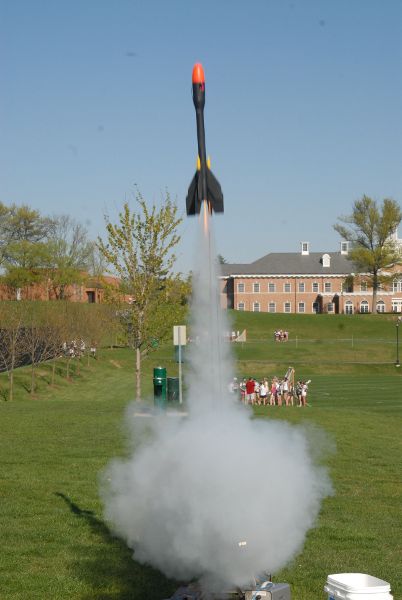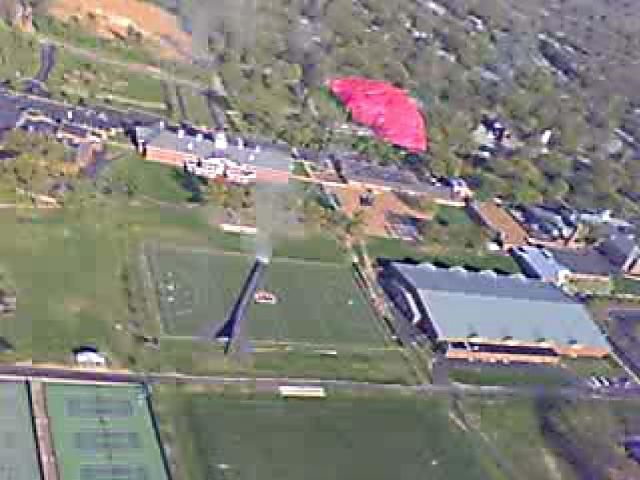This is "Darth Vado," a launch vehicle for a Creative Labs "Vado" flash video camera. About the size of a cell phone, the Vado will record up to an hour of VGA-resolution video with audio. The rocket is configured for either single-stage or two-stage capabilities. The upper stage can use D or E engines. The booster stage uses a D12-0 center engine plus twin A8-3 side engines to get the rather heavy rocket off the pad quickly. The A8-3s also deploy streamers to give the booster stage a somewhat softer landing.
The YouTube video is of the two-stage launch pictured to the right. Higher-quality copies of this plus a single-stage launch video on the same day are available below. The video is about two minutes long and includes about ten seconds of pre-launch countdown.


The upper stage and payload compartment each have their own 24" parachutes. If you go frame-by-frame through the longer video below, you can see the upper stage and its parachute in a few frames after the tumble that results from deployment of the payload from the upper stage. The frame shot to the left is the best of these frames. Although the image is of limited quality due to the Vado's video resolution, it makes for a spectacular and different in-flight view.
The 'chute for the payload section is attached inside and runs out through the joint between the body tube and nosecone. The Vado camera is angled down about 15 degrees in the payload compartment and once the parachute deploys, points at about a 45-degree down angle during recovery.
These launches took place at the Mary Institute and St. Louis Country Day School campus (MICDS) in the St. Louis suburbs on a beautiful April afternoon. The next experiment with "Darth Vado" will be to put an E9-7 in the upper stage and see how much more altitude we can get. Of course, that will take a bigger field and a very calm day so as not to lose the camera in the process.
To view these videos, you will need the "XVid" CODEC loaded up for Windows Media Player or whichever video viewer you use. One note: I have found that Windows Media Player crashes on certain computers when you try to download and play the video directly. However, if you right-click and save a copy, it will generally play ok when running from your local disc. Bill Gates is smarter than I am, so maybe he can explain why.
Once you have watched the video in real-time, you can get a better sense of the surroundings if you tell your media player to run at half-speed so the spinning isn't quite as disorienting.
The shorter video was shot with just the upper stage and a D12-3 single-stage engine. The rocket was never very high, probably only about 300' or so when the 'chute deploys. (Be forewarned, this is an 11-meg .avi file.)
The longer video was shot on the launch pictured above, with the booster stage and upper stage integrated. I estimate an apogee of somewhere between 500' and 1,000' on this launch. The video is about three times as long (and the file three times as big at almost 35 meg). On this launch, both the camera section and upper stage drifted over and onto the roof of the north campus athletic facilities, making for "interesting" recovery.
Ok, are you dizzy now?